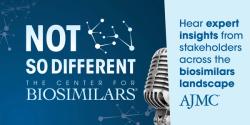© 2025 MJH Life Sciences™ and The Center for Biosimilars - Biosimilars, Health Economics & Insights. All rights reserved.
Published Data Coupled With Real-world Evidence Show Safety of Biosimilar-to-Biosimilar Switching
At the Festival of Biologics, Hillel Cohen, the executive director of scientific affairs at Sandoz, shared the current body of literature on biosimilar-to-biosimilar switching, saying that although there isn’t much published data, the vast real-world experience demonstrates the safety of this type of medication switch.
Although there is a lot of published evidence showing the safety of switching from a reference product to a biosimilar, the body of literature on biosimilar-to-biosimilar switching is growing, according to Hillel Cohen, the executive director of scientific affairs at Sandoz, in a presentation at the Festival of Biologics.
The presentation was entitled “Biosimilar-to-Biosimilar Switching: The Most Current Data” and the conference took place from March 20 to March 22, 2023 in San Diego, California.
Cohen mentioned that the majority of published data is based on observational evidence, which may call the quality of the data into question because they are not from randomized controlled studies (RCTs). However, these data are all that are available because companies and other research entities are not likely to make the investment in conducting RCTs.
“You’re not really going to get [those studies] for the biosimilar-to-biosimilar switching because the manufacturer isn’t going to purchase another company’s biosimilar to do a switching study. It’s expensive and the goal is to get your product approved, so you’d rather do your study against the originator. Not many academic centers are going to spend that much to buy both products either, so there's really probably low level of interest…. Observational studies are just what we have and it’s not surprising,” he said.
The published data showed that biosimilar-to-biosimilar switching did not disrupt clinical outcomes or impact immunogenicity.
Of the 4 published reviews, the first was a descriptive review with 9 studies and was published in 2021; the second was a systematic review with 23 studies; the third was sponsored by the World Health Organization and contained 19 studies; and the last was published in November 2022, containing 15 studies. However, because there’s not a single systematic review, Cohen wanted to see whether some studies were being counted twice. In addition, a few studies had been published since the end date of the fourth review.
Because of this, Cohen conducted his own literature review of biosimilar-to-biosimilar transition data to ensure that the data was as up to date as possible and did not overlap between analyses. There may have been some studies missing from the reviews because some of the keywords typically used during the literature search were missing.
Cohen’s review contained 23 studies assessing 3657 patients through December 2021. The studies assessed biosimilar-to-biosimilar switches for adalimumab, etanercept, infliximab, and rituximab. Cohen also searched multiple databases to see if there were studies on epoetin molecules; neutrophils, which are considered biosimilars outside of the United States; and bevacizumab products. A peer-reviewed journal and congressional abstract searches were conducted as well.
The overall conclusion of the review was that biosimilar-to-biosimilar switching did not produce any clinically meaningful differences in safety, effectiveness, pharmacokinetic parameters, patient acceptance, or immunogenicity.
Additionally, Cohen noted that most of the real-world evidence supporting biosimilar-to-biosimilar switching has not been published because these switches happen often in countries with tender systems, where 1 or more biologics will have market exclusivity for a certain amount of time, as well as within Veteran Affairs (VA). Thus, data isn’t being collected or analyzed for publication.
“The VA system switched from Remicade [reference infliximab] to Inflectra [infliximab biosimilar] to Renflexis [infliximab biosimilar]. So, patients there were switched from one to another. Whole countries have switched using the tender system. Hungary switched G-CSF [granulocyte-colony stimulating factor] and the somatropin products, Denmark switched. Norway switched. These are not necessarily published but when we know that they will switched based on the tenders. So, this is happening in a real-world setting.”
Since the end of Cohen’s review, 6 more studies have been published that included data on 804 patients. Three of the studies included new data, 2 were peer-reviewed publications, and 1 was a use pattern study from the FDA. The peer-reviewed publications may have had some overlapping data and the FDA study looked at biosimilar products within the Medicare fee-for-service system and did not look at safety or efficacy data. As a result, Cohen only counted the 3 with new data.
Overall, 26 biosimilar-to-biosimilar switching studies have been published, containing data on over 4000 patients. Each study has its own limitations and some are more rigorous than others. Each has its own follow-up period and endpoints and they have different cohort sizes. “That doesn't mean we have to dismiss them. Basically, it's collective whole that we're looking at,” said Cohen.



